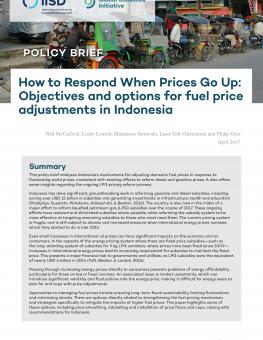
How to Respond When Prices Go Up: Objectives and options for fuel price adjustments in Indonesia
There are options to strengthen the fuel pricing mechanism in Indonesia. This policy brief highlights some options, including price smoothing, ratcheting and installation of price floors and caps, closing with recommendations.
This policy brief analyzes Indonesia’s mechanisms for adjusting domestic fuel prices in response to fluctuating world prices, consistent with existing efforts to reform diesel and gasoline prices. It also offers some insights regarding the ongoing LPG pricing reform process.
Indonesia has done significant, ground-breaking work in reforming gasoline and diesel subsidies, including saving over USD 15 billion in subsidies and generating investments in infrastructure, health and education. The country is also now in the midst of a major effort to reform liquefied petroleum gas (LPG) subsidies over the course of 2017. These ongoing efforts have reduced and eliminated subsidies where possible, while reforming the subsidy system to be more effective at targeting remaining subsidies to those who most need them. The current pricing system is fragile, and is still subject to shocks and increased pressure when international energy prices increase, which they started to do in late 2015.
Even small increases in international oil prices can have significant impacts on the economy and on consumers. In the aspects of the energy pricing system where there are fixed price subsidies—such as the long-standing system of subsidies for 3 kg LPG canisters, where prices have been fixed since 2009— increases in international energy prices lead to increasing requirement for subsidies to maintain the fixed price. This presents a major financial risk to governments and utilities, as LPG subsidies were the equivalent of nearly USD 4 billion in 2014.
Passing through increasing energy prices directly to consumers presents problems of energy affordability, particularly for those on low or fixed incomes. An associated issue is market uncertainty, which can introduce significant volatility and fluctuations into the energy price, making it difficult for energy users to plan for and cope with price adjustments.
Approaches to managing fuel prices include ensuring long-term fiscal sustainability, limiting fluctuations and minimizing shocks. There are options directly related to strengthening the fuel pricing mechanism, and strategies specifically to mitigate the impacts of higher fuel prices. This paper highlights some of these options, including price smoothing, ratcheting and installation of price floors and caps, closing with recommendations for Indonesia.
Participating experts
You might also be interested in
The Cost of Fossil Fuel Reliance
Government support for fossil fuels reached at least USD 1.5 trillion in 2023, new data shows.
Increased Support Needed to Achieve India's Clean Energy Goals
India is on track to achieve many of its 2030 clean energy goals but needs to step up government support measures to accelerate the deployment of offshore wind, electric vehicles, and green hydrogen, according to a new report.
Ending Export Credits for Oil and Gas: How OECD countries can end 2024 with a climate win
For a year now, Organisation of Petroleum Exporting Countries (OECD) governments have been negotiating an agreement that could put an end to oil and gas export finance. Following the acrimony in Baku, this would be a very real way for the OECD to show policy coherence, respond to calls from the poorest countries to stop subsidizing fossil fuels, and shift public finance to solutions.
Fossil Fuel Production, Renewable Energy, and Subsidy Reform in Nationally Determined Contributions 3.0
This policy brief provides an analysis of the critical benchmarks and recommendations necessary for aligning nationally determined contributions (NDCs) with the 1.5 °C target.